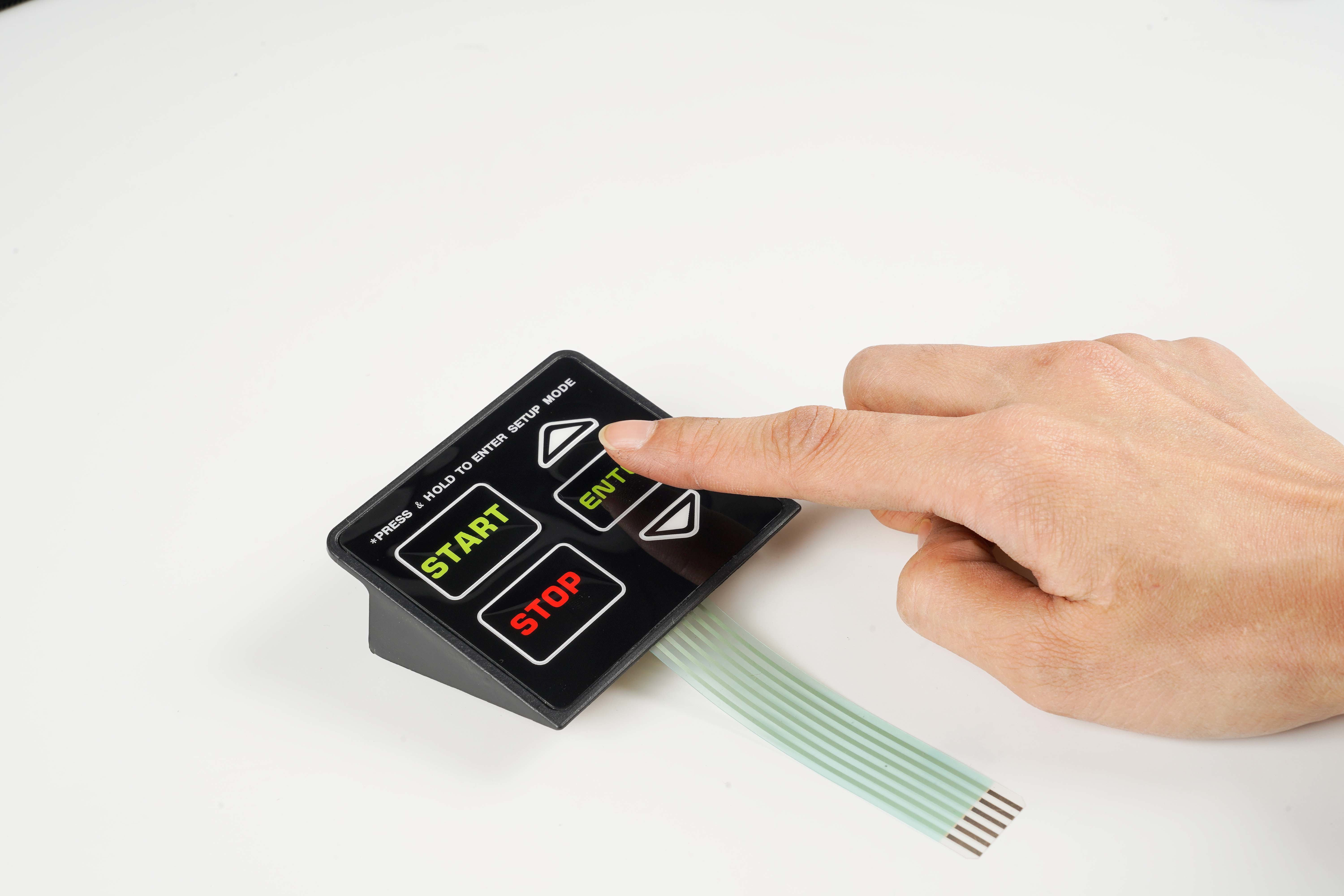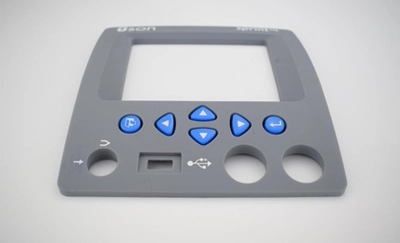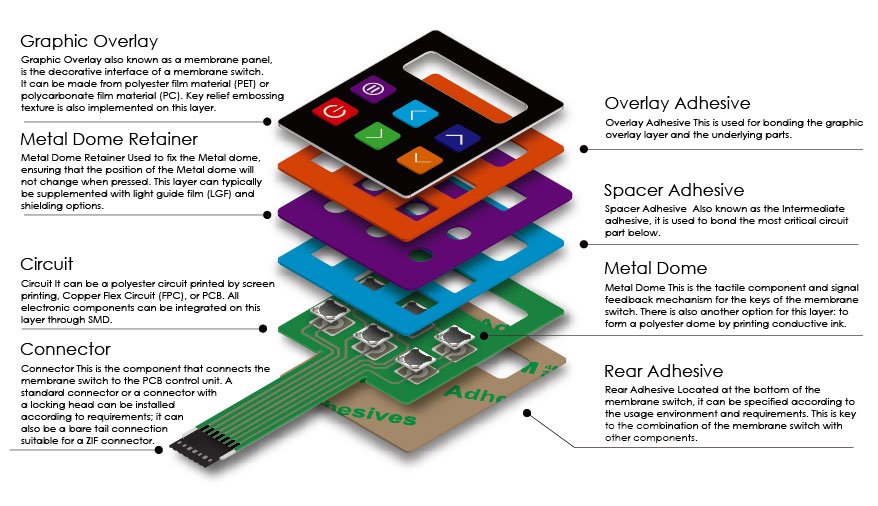The Production Process Behind Membrane Change: What You Need to Know
The production process behind membrane switches over combines mindful design, material selection, and quality assurance. It starts with understanding the ins and outs of membrane layer button layout and progresses through numerous stages, including product options and printing methods. Each phase plays a crucial function in guaranteeing capability and resilience. The complexities of layer building and the rigorous testing requirements might expose insights that are not quickly obvious. What exists past these fundamental components?
Understanding Membrane Layer Change Style
Although membrane switches may appear basic at initial glimpse, their style entails intricate considerations that assure functionality and resilience. The design procedure starts with an extensive understanding of individual demands, consisting of the interface's designated application and ecological aspects. Ergonomics is a crucial element, as the design should assist in convenience of use while ensuring that tactile comments fulfills user expectations.Moreover, the layering of components, such as visuals overlays, sticky layers, and conductive traces, need to be precisely engineered. membrane switch. This split configuration not only affects the button's responsiveness however also influences its longevity. Attention is provided to the sealing techniques utilized to safeguard versus dampness and dirt, which might compromise efficiency. Furthermore, layout factors to consider include appearances, where color pattern and visual clarity improve user experience. Eventually, the style of membrane layer changes balances functionality, user experience, and sturdiness, making certain that they fulfill the demands of different applications properly
Products Made Use Of in Membrane Change Production
When selecting products for membrane switch production, it is important to ponder both efficiency and resilience. The main materials consist of polyester and polycarbonate films, which offer adaptability and toughness. These movies are usually covered with sticky to guarantee correct bonding to substratums. Conductive inks, commonly made up of silver or carbon, are critical for developing electric connections within the button, permitting trustworthy operation.Additionally, a protective layer, such as a tough coat, is often put on enhance scratch resistance and longevity. The selection of backing material, such as acrylic or foam, can substantially impact the button's responsive feel and total user experience. In addition, various ecological aspects, including temperature and moisture, need to lead material selection to guarantee peak efficiency in certain applications. Ultimately, the ideal mix of materials contributes to the membrane switch's capability and lifespan, making notified choices important for producers.
The Printing Process: Creating Video and Text
The printing procedure in membrane layer switch production plays a significant function in creating high-grade graphics and text. Numerous graphic style methods are employed to guarantee aesthetic charm and capability, while cautious ink choice approaches are vital for toughness and performance. Comprehending these elements is fundamental for accomplishing ideal outcomes in membrane switch design.
Graphic Style Techniques
Graphic design techniques play a vital duty in the printing procedure of membrane layer buttons, as they define how graphics and text will ultimately appear on the end product. Reliable visuals style includes the calculated use of font styles, colors, and designs to boost readability and aesthetic charm. Designers usually use vector graphics for scalability, making certain that photos stay sharp at various sizes. In addition, interest to contrast and alignment is vital, as it affects individual interaction and visual quality. The unification of branding aspects, such as logo designs, have to be taken care of with like maintain brand integrity. Overall, thoughtful graphic layout methods add substantially to the functionality and good looks of membrane layer buttons, affecting customer experience and item efficiency.
Ink Option Methods
Picking the appropriate ink is important for achieving the wanted visual quality and sturdiness in membrane layer button production. Various ink kinds are used, consisting of solvent-based, water-based, and UV-curable inks. Each kind offers unique characteristics, such as flexibility, resistance, and adhesion to environmental elements. Solvent-based inks are commonly preferred for their sturdiness and lively colors, while water-based inks are a lot more ecologically friendly yet might have constraints in adhesion. UV-curable inks offer quick treating and robust efficiency. Furthermore, color matching strategies assure that the chosen inks align with layout specifications. Eventually, the option of ink should consider elements such as application method, substratum compatibility, and end-use needs to achieve premium cause membrane layer switch graphics and text.
Layer Construction and Assembly

Product Selection Process
A mindful choice of products is important in the production process of membrane layer buttons, as it straight affects functionality and durability. The key products utilized consist of polyester, polycarbonate, and various conductive inks. Polyester is typically favored for its excellent resistance to chemicals and abrasion, making it ideal for extreme atmospheres. Polycarbonate, on the various other hand, supplies premium quality and effect resistance, which is advantageous for applications requiring exposure and toughness. Conductive inks, commonly composed of silver or carbon, are vital for producing dependable electric pathways. In addition, the selection of glue materials affects the overall honesty of the switch - membrane switch. Assessing variables visit this page such as ecological direct exposure, tactile comments, and visual requirements overviews manufacturers in choosing the ideal materials for their particular applications
Layer Attachment Strategies
Adhering layers in membrane layer switch construction is an important procedure that assures functionality and durability. Numerous adhesion strategies are employed to secure perfect bonding between layers, which commonly include the use of adhesives, heat, and stress. Pressure-sensitive adhesives (PSAs) are frequently made use of for their ease of application and instant bonding capacities. Additionally, thermal bonding techniques can be used, where warm is used to turn on glue properties, protecting a strong bond. The choice of attachment method mainly depends on the products involved and the details application demands of the membrane layer switch. Correct positioning and uniform application of adhesives are important to protect against defects, protecting the switch runs properly throughout its intended life-span.
Top Quality Control Procedures
Guaranteeing quality assurance during the layer building and setting up of membrane layer buttons is necessary for keeping efficiency and reliability. This process normally involves several important actions, including thorough assessments at each stage of manufacturing. Manufacturers utilize sophisticated screening techniques, such as peel examinations and attachment assessments, to confirm the stability of layer bonds. Furthermore, aesthetic examinations are conducted to recognize any kind of defects in printing or product disparities. Environmental problems, such as temperature and moisture, are meticulously monitored to assure excellent treating and attachment. Routine calibration of devices assists preserve precise production criteria. By carrying out these high quality control steps, makers can significantly reduce the threat of product failing, ensuring that the final membrane layer switches over meet the needed specs and consumer assumptions.
Checking and High Quality Control Steps

Developments in Membrane Layer Switch Modern Technology
As innovations in modern technology continue to develop, membrane switches are benefiting from ingenious growths that enhance their performance and customer experience. One significant advancement is the assimilation of capacitive touch technology, which permits more user-friendly and receptive interface. This shift not just boosts aesthetic appeals but additionally decreases mechanical wear and tear, extending the lifespan of the switches.Additionally, innovations in graphic overlay products have caused boosted resilience and resistance to ecological aspects such as wetness and UV light. These materials currently supply improved clarity and illumination, additional raising the visual appeal.Furthermore, the incorporation of clever innovation is changing membrane switches over into interactive control board, making it possible for connection with IoT gadgets. This connection fosters a smooth user experience, leading the way for applications in various sectors, from medical care to consumer electronics. Collectively, these advancements placement membrane layer switches over as essential components in modern-day tool layout.
Often Asked Concerns
How much time Does the Membrane Layer Switch Production Refine Take?
The duration of the membrane layer switch manufacturing procedure can differ significantly. Variables such as complexity, products utilized, and production quantity impact timelines, with regular production ranging from a few days to a number of weeks for completion.
What Are the Typical Applications for Membrane Switches?
Membrane switches are generally made use of in different markets, including automotive controls, family devices, clinical devices, and customer electronics (membrane switch). Their flexibility and resilience make them optimal for applications calling for user-friendly user interfaces and dependable efficiency in diverse settings
Can Membrane Switches Over Be Customized for Specific Requirements?

What Is the Lifespan of a Common Membrane Switch Over?
The life-span of a common membrane layer button differs, yet usually, it ranges from 1 to 5 million cycles. Factors such as use, atmosphere, and material top quality substantially influence longevity and overall efficiency gradually.

Are Membrane Changes Eco-friendly?
The ecological friendliness of membrane switches over differs. Some products used may not be recyclable, while others can be environment-friendly. The general effect relies on producing practices and materials, demanding cautious factor to consider throughout option and disposal. The production procedure behind membrane layer switches combines mindful layout, material option, and top quality control. It starts with understanding the ins and outs of membrane layer switch layout and proceeds with various phases, consisting of material selections and printing methods. When picking materials for membrane button manufacturing, it is crucial to contemplate both efficiency and toughness. A mindful option of materials is crucial in the manufacturing procedure of membrane buttons, as it straight more info here affects functionality and toughness. The selection of adhesion approach greatly depends on the products included and the details application needs of the membrane layer switch.